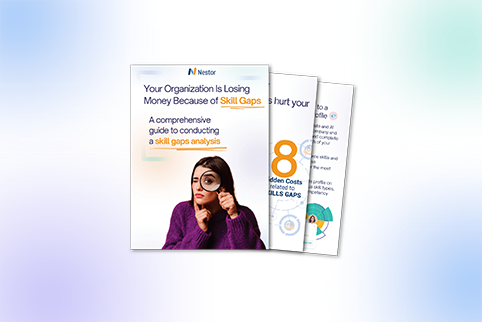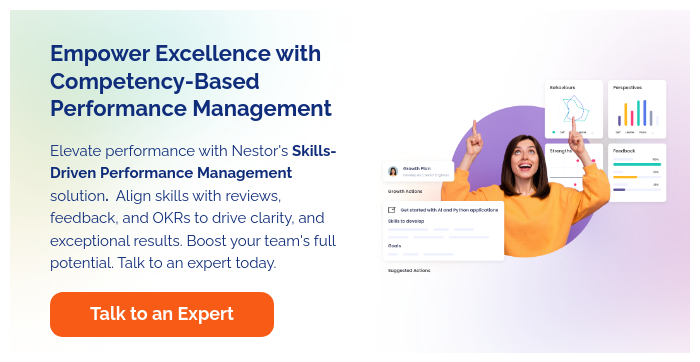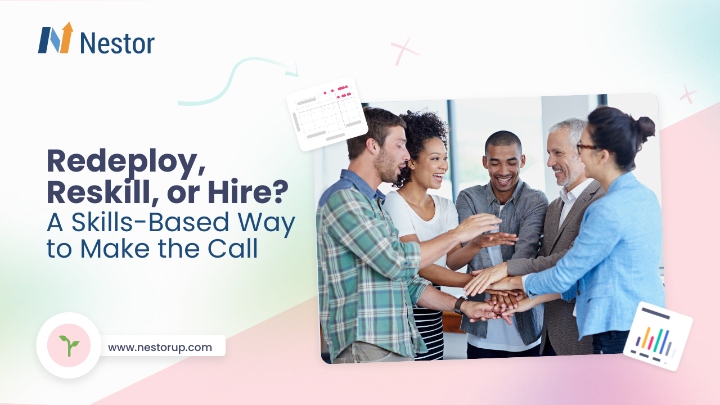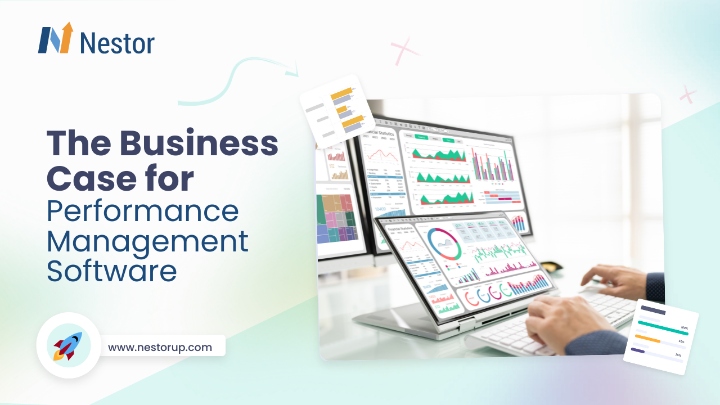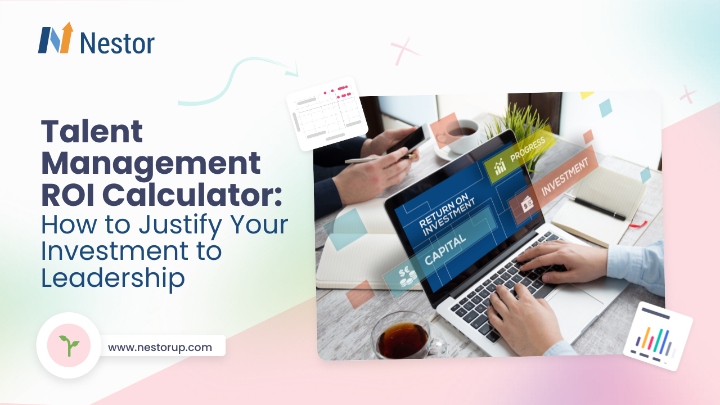Competency-Based Performance Management: Benefits and How to Implement It
26 min read

Contents
Now more than ever, organizations face increasing pressure to maximize employee performance and productivity — all while simultaneously looking at L&D and professional development as answers to the current talent shortages and skill gaps.
And since traditional systems often fall short in addressing these complex demands, approaches like competency-based performance management are emerging as a possible answer. This framework shifts the focus from annual reviews to an ongoing process focused on future employee development through nurturing specific competencies and behaviors, which are essential for success in a given role.
Let’s jump right in and find out the secrets behind competency-based performance management and the steps necessary for adopting this approach.
What is competency-based performance management?
Competency-based performance management is a way of assessing and improving employee performance by focusing on the skills, behaviors, and personal qualities, or what we call competencies, that make someone successful in their role. Instead of relying solely on what employees have achieved in the past, this approach is all about how they perform their work and the specific traits that help them do it well.
The idea here is simple: you’re not just evaluating employees for the tasks they’ve completed; you’re looking at how they approach their job, how they interact with others, and how they grow over time. It’s about creating an environment where employees can continually develop and take on new challenges, whether that’s in their current role or the next one.
By focusing on competencies, organizations give employees a clear understanding of what is expected of them and how they can improve. This makes performance management a more dynamic, ongoing process rather than something that only happens once a year. Employees receive regular feedback, and managers get a better sense of who needs support in what areas.
Why Competencies Matter
Think about the last time you worked on a team project. Sure, you had specific tasks to complete, but what really made the project work? It was probably the way people communicated, how they solved problems together, and how everyone kept things moving forward despite obstacles. Those are the competencies that really make a difference.
In a competency-based system, the goal is to nurture those kinds of behaviors, like problem-solving, collaboration, leadership, and adaptability. These are the traits that help people succeed in their roles, and they’re just as important as technical skills or achieving targets.
So, why is this important? Because focusing on competencies creates a stronger foundation for the whole team. When everyone knows what’s expected in terms of behavior and attitude, you avoid confusion, miscommunication, or even frustration. People know exactly what they need to improve on, and they can see how their growth ties directly to their future at the company.
Shifting Focus from Results to the How
With competency-based performance management, the spotlight shifts from the results of someone’s work to how they got there. Hitting a target or completing a project is important, but how did you do it? Did you work well with others? Did you demonstrate leadership even when things weren’t going smoothly? Were you proactive in finding solutions?
The emphasis is on the process as much as the outcome. This helps keep the focus on continuous improvement. If someone is struggling in an area like communication or teamwork, it’s not just about telling them they didn’t meet expectations. It’s about giving them specific feedback on how to get better at those competencies, which will help them in the long run.
Competency-based performance management vs traditional performance management
There are clear differences when you compare competency-based performance management with the traditional model. Traditional systems often focus primarily on the past, looking back at what employees have accomplished, with annual reviews serving as the primary touchpoint.
These reviews tend to be about ticking boxes and measuring past results. The question is: What did you achieve? The problem is that this method doesn’t always highlight how someone achieved those results or what behaviors helped them get there.
This is where competency-based performance management takes a different approach. Instead of just looking at past outcomes, it digs deeper into the “how” of achieving those results; the behaviors, processes, and skills that drive success. How did employees approach challenges? Did they show initiative, communicate well, or collaborate effectively? This focus on how goals are reached allows employees to not only reflect on their past performance but also identify areas for growth in real-time.
The beauty of competency-based management is that it looks forward. Rather than solely evaluating what’s been achieved, it encourages continuous growth and improvement. So, if an employee did well in the past, the next step is helping them build on that success and raise their game for future challenges. It’s less about looking backward and more about pushing forward, always with an eye on what comes next.
Another key distinction is the feedback loop. While traditional performance management often relies on those long, drawn-out annual reviews, competency-based performance management focuses on regular, ongoing conversations.
Frequent check-ins, one-on-one meetings, and feedback sessions become the norm, allowing for timely adjustments and development. This shift helps employees feel more connected to their goals and growth, avoiding the typical disconnect that can happen when feedback is limited to once a year.
Decide On Objectives vs. Goals and Behaviors
An important step you should decide upon is whether to focus the discussion around clearly defined behaviors solely or around these behaviors and their connection to operational goals.
What’s the focus of your performance management system? Are you just setting clear objectives, or are you also looking at how those objectives are tied to behaviors and personal development? It’s a fine line, but one that can make all the difference.
Competency-based systems don’t just focus on outcomes. They also emphasize behaviors and competencies that drive those outcomes. When you decide to shift your focus to behaviors and competencies, you’re not just measuring if someone hit a target; you’re looking at how they worked to achieve it. Were they collaborative? Did they show leadership or problem-solving skills? It’s about recognizing the full picture of performance not just the numbers.
At Nestor, we provide a holistic approach to performance and talent management through regular check-ins, goal management, competency-based performance reviews, and personalized development plans and opportunities focused on continuous employee growth.
Key Areas to Focus on in Competency-Based Performance Management
Here are a few important elements to consider when adopting a competency-based performance management approach:
- Behavioral Expectations: Focus on the behaviors that drive success in a given role. This could be communication, collaboration, or leadership skills. Defining these behaviors clearly ensures everyone is on the same page.
- Linking Competencies to Business Goals: It’s not just about individual performance. Look at how the competencies align with organizational goals. Are employees’ behaviors and attitudes helping the business move forward?
- Regular Feedback: Frequent, constructive feedback is crucial. Employees need to know where they’re excelling and where they can improve to stay on track. It’s about continuous improvement, not just an annual review.
- Individual Development Plans: Personal development plans should be tied to specific competencies. By focusing on growth areas and offering tailored learning opportunities, organizations can help employees enhance their skills and competencies over time.
- Flexibility in Goal Setting: In a competency-based system, goals are dynamic. They evolve as employees develop their competencies, so the objectives and targets shift to match new strengths and areas of growth.
By emphasizing these areas, you can ensure that your performance management system remains flexible, forward-looking, and deeply focused on the personal and professional growth of employees. It’s not about rigid targets, but about empowering your workforce to continue developing and performing at their best.
Benefits of adopting a competency-based performance management system
Significantly improves performance review outcomes
The reality is many employees dread the one-on-one annual performance appraisal. It’s simply outdated and fails to deliver the support needed to encourage and promote growth in the modern work environment. And it’s susceptible to subjective assessments and things like the recency bias.
With competency-based performance management, you’ll have a solid framework for evaluating and managing the performance of your employees — and they, in turn, will know exactly what’s expected from them and how they match up against those expectations.
Moreover, by focusing the discussion on specific competencies and behaviors employees exhibit, you will help minimize the negative feelings that can occur when discussing weaknesses.
Streamlines the succession planning process
Succession planning is a critical but often overlooked aspect of strategic workforce planning. As a direct result, organizations end up losing key expertise and experience due to retirements or unexpected departures.
The competency-based approach helps you identify potential leaders early on, who can then be (with their agreement) enrolled into leadership development programs — especially job shadowing and mentoring — so that you can nurture a strong pipeline of top talent who are ready to replace the most experienced people inside the company.
Clarifies expectations and performance requirements
Confusion around performance expectations or job requirements in general can lead to different undesirable situations, including unhappy or unengaged employees and unproductive or surprising discussions and opinion differences during performance reviews.
Luckily, these can be easily avoided with a competency-based performance management model, since both competencies and the competency profile of each job role are transparent to managers and employees alike, ensuring everyone knows what’s expected from them.
Makes professional and career development transparent
The transparency mentioned in the previous point also has another highly beneficial effect — every person inside the company knows what they need to do to either grow in their current position or make the next move.
And this doesn’t need to be limited to traditional promotions or vertical moves. In fact, it opens the door to more dynamic and flexible career paths and moves, which any employee can make as long as their profile matches the competency profile of the new role.
How to create and implement a competency-based performance management system
1. Establish the type of competencies within your organization
The first step is defining the various types of competencies, which can include:
- Core competencies: These usually apply to all roles and are aligned with the larger organizational identity, vision, and goals. They help the company stand out. For example, excellent customer service is one of the core competencies of the tech-giant Apple.
- Competencies specific to business units: Strategic planning is a great competency example for HR and Marketing departments.
- Specific to job groups competencies: Attention to detail or error-free verification is critical for accountants.
- Competencies specific to a job: Leadership is a good example for team leads, supervisors, or department heads.
2. Map competencies to each job role
Mapping competencies to individual job roles is an integral part of creating an organization-wide competency framework. When assigning competencies, it’s important to differentiate between core or functional competencies (the must-have for each role) and technical competencies.
Keeping competencies and the competency profile of each role up-to-date is critical because both can evolve over time. This is why we recommend being aware of the competency requirements in your industry and adjusting accordingly.
Once competencies are defined, you should also include them in job descriptions, which, in addition to performance management and expectations, will also help with transparency over various career paths and internal mobility opportunities.
3. Conduct competency-based performance reviews
Once your competency framework is in place and everyone within the company is aware of it, you can start conducting performance reviews that are based on competencies. This shift will likely require additional training and support for your managers.
Competency-based performance appraisal
In a competency-based performance management system, managers use appraisals to evaluate both the current level and the consistent demonstration of each competency, usually through a grading or rating system.
In this type of review, employees are assessed against a set of pre-defined competencies for their particular role or what’s expected from them in that role. Employees also have the opportunity to assess themselves and, at the end of the process, have conversations with their managers, compare the two perspectives, and focus on future growth actions.
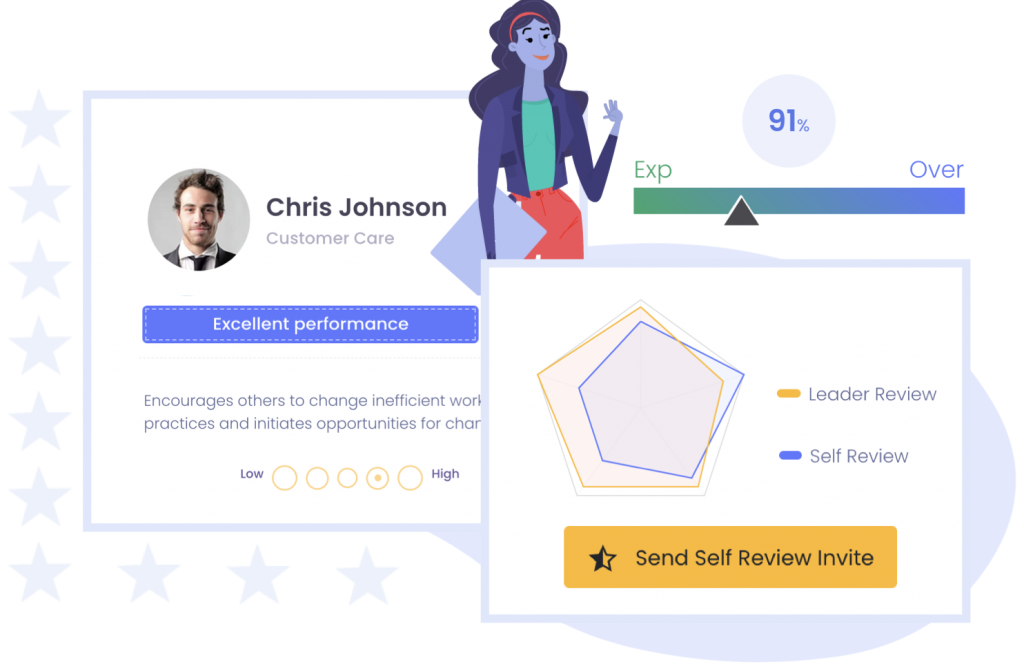
Competency-based 360 feedback
In competency-based performance management, anonymous 360-degree or multi-source feedback is an excellent opportunity to better understand how someone performed over a certain period or as part of a team.
The feedback can come from multiple sources — interns, juniors, peers, direct reports, supervisors — and offers a more holistic image of a person’s competencies and how well they have demonstrated those competencies while performing day-to-day tasks.
These insights will highlight both strong and lower-rated competencies, revealing hidden strengths, areas for improvement, and also different perspectives (self, manager, peers) on how an employee uses their competencies to meet performance expectations.
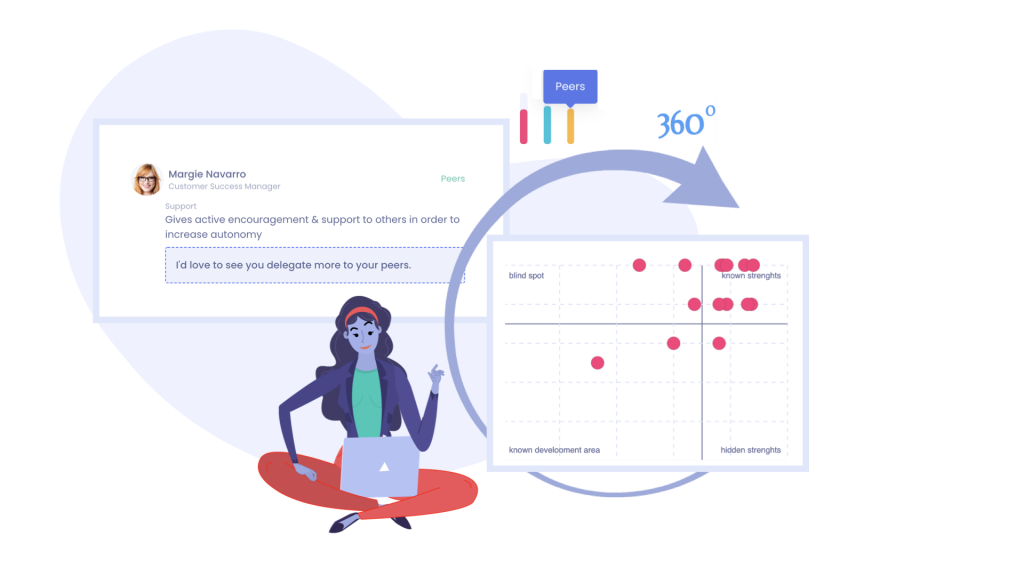
4. Develop growth plans and assign L&D opportunities for each competency
Once competency gaps are identified, the managers can sit together with each team member and establish growth plans for improving each competency. Together, they will decide what steps are necessary to further advance individual competencies and what areas of improvement will be given priority.
For example, on the Nestor platform, this type of plan consists of outlining clear goals, specifying growth actions closely linked to the skills and competencies you need to master, and establishing the methods used to track and evaluate progress over time.
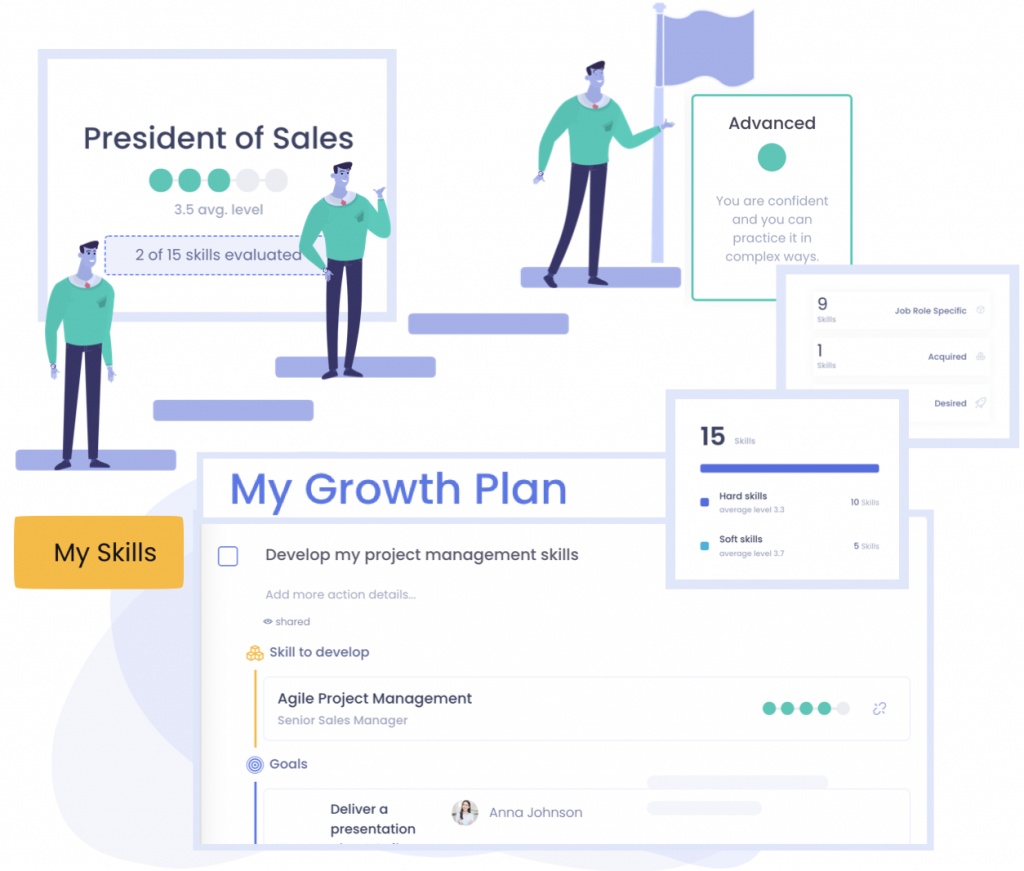
In the example below, you can see Anna, our made-up employee, seeking to improve her collaboration competency to level 5: advanced, making progress from her last evaluation, when this competency was ranked to 4: proficient level. In Nestor, we use a rating system with 5 levels: aware of, beginner, familiar with, proficient, and advanced.
Anna’s goal is to become even more efficient in her team and, in this particular case, seeking to participate in a project is the growth action chosen to further develop her collaboration competency.
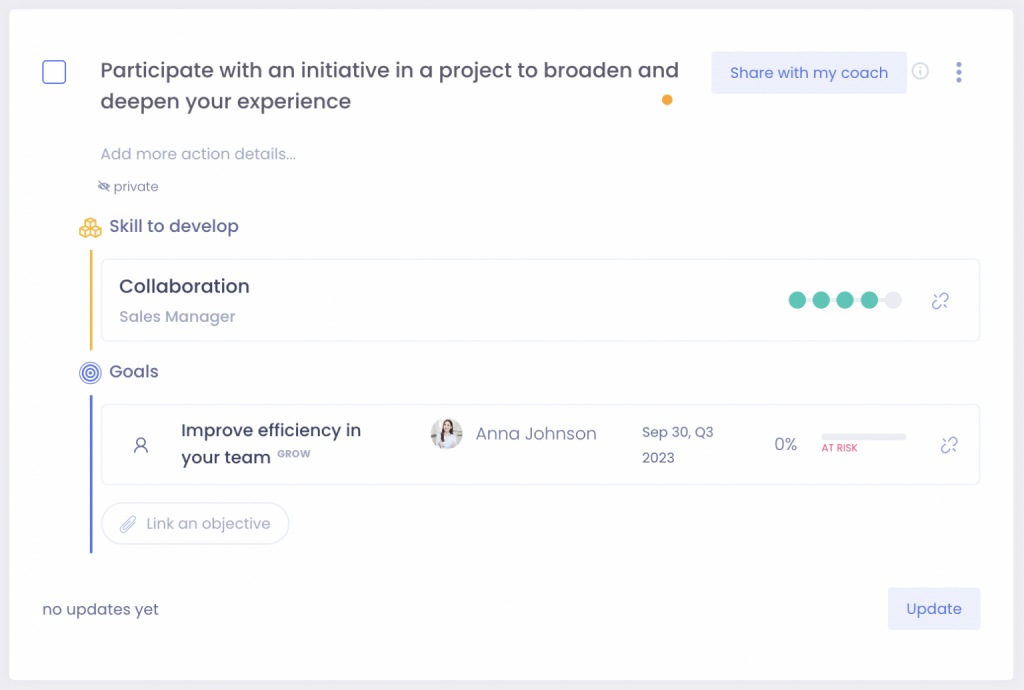
5. Monitor and evaluate the impact of the new competency-based performance management system
Monitoring the impact and effectiveness of the new competency-based approach should happen regularly.
It’s not only about having and maintaining detailed and diligent documentation, but rather identifying what’s working and what isn’t — and ensuring that both competencies and the competency-based system itself are still aligned with the larger business objectives.
The most relevant feedback about the new system will come from managers and employees, who will be impacted the most by this transition. It’s important to listen to their pain points and suggestions and leverage anonymous feedback forms to gather honest and useful opinions. You can then make revisions as required.
How Nestor can help you transition to a competency-based performance management system
Competency-based performance management represents a dynamic and future-oriented framework that enhances clarity, fairness, and transparency in evaluating employee performance — thus enabling and nurturing growth and development.
And since Nestor is a skills- and competencies-first platform, our integrated solutions are uniquely positioned to help organizations unlock the Power of Skills and Competencies to drive workforce agility, high performance, and continuous growth.
With Nestor, you’ll be able to run competency-based performance reviews and understand also how work is done not only what it is achieved, pinpointing specific areas where employees need to further develop their capabilities.
Schedule a free demo session and let our consultants walk you through the whole process of defining competencies, running competency-based performance reviews or 360 feedback, and finally closing the loop with customized employee development plans.
Measuring the ROI of Competency-Based Performance Management
Implementing a competency-based performance management system takes time, resources, and commitment. To understand whether the system is truly delivering value, it’s crucial to measure the return on investment (ROI). But how exactly do you assess ROI in this context? Here are some specific ways to measure the impact of a competency-based approach on your organization:
1. Employee Engagement and Satisfaction
One of the first ways to measure ROI is by assessing employee engagement and satisfaction. A competency-based system provides clear feedback and regular development opportunities, which can directly influence how engaged employees are with their work. By tracking engagement levels, organizations can see whether employees feel more supported and motivated, which is often a strong indicator of the system’s success.
How to Measure:
- Engagement Surveys: Regular employee engagement surveys or pulse surveys can gauge how employees feel about their growth opportunities, feedback, and overall satisfaction.
- Retention Rates: Increased engagement typically leads to lower turnover, so compare turnover rates before and after implementing the system.
- Employee Feedback: Collect direct feedback from employees through interviews or focus groups to understand how the competency-based system affects their motivation and job satisfaction.
2. Improvement in Performance Outcomes
A key metric for measuring ROI is the direct correlation between competency development and improved performance. By tracking how employees develop competencies and comparing those improvements to performance outcomes, you can gauge whether the system is making a measurable difference in productivity, efficiency, and goal achievement.
How to Measure:
- Performance Metrics: Compare productivity, project completion rates, or sales performance before and after the introduction of the competency-based system.
- Goal Achievement: Assess how well employees are meeting their goals. Are they achieving higher or more complex goals? Look at the success rate of employee goal-setting and completion.
- Quality of Work: Evaluate the quality of output in relation to competency growth. Are employees demonstrating better problem-solving, collaboration, or leadership?
3. Cost Savings from Reduced Turnover
Employee turnover is costly. One way to measure ROI is by tracking whether a competency-based system leads to reduced turnover. By providing employees with a clear path for growth and continuous feedback, the organization can increase retention rates, which will reduce hiring and training costs.
How to Measure:
- Turnover Rates: Compare turnover rates before and after implementing the competency-based system. A significant reduction in turnover can indicate the system’s positive impact on employee satisfaction and retention.
- Recruitment Costs: Track the costs associated with hiring new employees. Reduced turnover means fewer recruitment efforts and lower hiring costs.
- Training Costs: When turnover is reduced, you spend less on onboarding and training new hires. Track the cost savings from having fewer new employees to onboard.
4. Internal Promotion and Leadership Development
A competency-based system can also be assessed by its impact on internal promotion rates and leadership development. By identifying high-potential employees and providing them with the right development opportunities, organizations can reduce the need for external hiring for leadership roles.
How to Measure:
- Promotion Rates: Track the number of internal promotions compared to external hires. A successful competency-based system should increase the rate of internal promotions as employees develop the required competencies.
- Leadership Pipeline Strength: Measure the number of emerging leaders identified through competency assessments. Are more employees being identified as ready for leadership roles? A stronger leadership pipeline indicates that the competency-based system is helping develop future leaders.
- Leadership Success Rates: Track the success rate of internal promotions to leadership roles. Are those who were developed through the competency-based system performing well in their new roles?
5. Return on Learning and Development Investments
Another important area to measure is the return on investment for learning and development (L&D) programs. Competency-based performance management often involves targeted training programs to develop specific competencies. Measuring the effectiveness of these programs is critical to understanding the ROI.
How to Measure:
- Training Effectiveness: Measure the performance improvements before and after training. Are employees who complete competency-based training programs demonstrating improved skills or behaviors?
- L&D Cost per Employee: Track the cost of training and compare it with the improvement in employee performance. If employees are more effective and efficient after training, the ROI of the program increases.
- Behavioral Improvements: Use 360-degree feedback or peer reviews to measure how well employees are applying newly learned competencies in their day-to-day work.
Key Competencies to Focus on for Future-Ready Teams
As organizations look ahead, the need for employees to adapt, innovate, and thrive in an ever-changing environment has never been more pressing. With industries evolving quickly, certain competencies are emerging as crucial to success. These are the competencies that will help employees stay flexible, creative, and equipped to solve challenges today and in the future.
1. AI Fluency and Prompt Engineering
As AI continues to shape industries, employees need to understand how to interact with AI systems effectively. AI fluency, including skills like prompt engineering, is becoming an essential competency. It’s no longer enough to just use AI tools. Employees must understand how to leverage these systems to enhance their productivity and problem-solving capabilities.
Why It Matters:
- Adaptability with AI: AI fluency helps employees stay competitive in an increasingly tech-driven world.
- Problem-Solving: With AI, employees can solve more complex problems more efficiently.
- Innovation: Those who understand how to work with AI can drive innovation in their roles and the organization.
2. Creative Thinking and Innovation
Routine tasks are increasingly automated, meaning creativity is now a key differentiator in the workforce. Employees who can think creatively and come up with innovative solutions are in high demand. This competency is essential for organizations that want to stay ahead of the competition.
Why It Matters:
- Generates Novel Ideas: Creative thinking helps generate fresh solutions to old problems.
- Fosters Continuous Improvement: Innovation ensures that processes, products, and services continue to improve over time.
- Adapts to Change: Creative employees can adapt to shifts in the market or organization more quickly.
3. Cross-Cultural Communication
As workforces become more globalized, cross-cultural communication skills are more important than ever. Employees need to understand how to navigate diverse perspectives and work seamlessly with colleagues across different cultural backgrounds. This competency ensures that teams can collaborate effectively, no matter their location.
Why It Matters:
- Improved Team Dynamics: Strong cross-cultural communication promotes collaboration and reduces misunderstandings.
- Global Perspective: It enables employees to contribute to projects and initiatives that span multiple regions or countries.
- Inclusivity: Enhances inclusivity by respecting and valuing diverse viewpoints.
4. Ethical Judgment and Critical Thinking
In an increasingly complex world, ethical judgment and the ability to think critically are more important than ever. As organizations face new ethical challenges, employees with strong ethical reasoning and critical thinking skills can navigate difficult situations while making decisions that align with company values and societal expectations.
Why It Matters:
- Informed Decision-Making: Helps employees weigh the potential consequences of their actions.
- Aligns with Organizational Values: Supports integrity and trust within the organization.
- Navigates Ethical Dilemmas: Equips employees to make the right decisions in tough situations.
5. Emotional Intelligence (EQ)
Emotional intelligence (EQ) is a timeless competency that remains critical for effective leadership and teamwork. Employees with high EQ can build strong relationships, manage their emotions, and navigate interpersonal conflicts with ease, creating a more harmonious and productive work environment.
Why It Matters:
- Stronger Relationships: EQ helps foster positive relationships between colleagues, improving collaboration.
- Conflict Resolution: Employees with high EQ can manage conflicts without escalating tensions.
- Leadership: High EQ is key for effective leadership, as it helps managers understand and motivate their teams.
6. Data Literacy
As data-driven decision-making becomes the norm, employees must be equipped to understand, interpret, and leverage data effectively. Data literacy is about more than just the ability to read numbers; it involves understanding how to draw insights from data, make informed decisions, and use data tools to drive results.
Why It Matters:
- Informed Decision-Making: Data literacy helps employees make decisions based on evidence, improving accuracy and outcomes.
- Competitive Edge: Being data-savvy allows employees to contribute to analytics-driven strategies that enhance business performance.
- Efficiency: Employees can identify trends and patterns, enabling faster and smarter decision-making.
7. Resilience and Stress Management
In today’s fast-paced, high-pressure work environments, resilience is a must-have competency. Employees who can manage stress, stay focused during challenging times, and bounce back from setbacks contribute to a more productive and positive work culture.
Why It Matters:
- Mental Toughness: Resilient employees are better equipped to handle change, ambiguity, and high-pressure situations.
- Long-Term Wellbeing: Employees with good stress management skills are less likely to experience burnout, which is essential for long-term performance.
- Improved Productivity: When employees are able to manage stress, they maintain their productivity and stay engaged with their work.
8. Customer-Centric Mindset
In today’s competitive market, focusing on the customer is more important than ever. Employees must be attuned to customer needs, feedback, and expectations, ensuring that the business delivers a seamless and positive customer experience.
Why It Matters:
- Customer Retention: A customer-centric mindset helps retain loyal customers and builds stronger relationships.
- Business Growth: Employees who focus on customer needs can identify opportunities for upselling, cross-selling, and improving products or services.
- Brand Loyalty: A consistent focus on customer satisfaction enhances the organization’s reputation and fosters brand loyalty.
Final Thoughts on Competency-Based Performance Management
As organizations navigate the complexities of the modern workplace, adopting a competency-based performance management system emerges as a strategic approach to foster growth, adaptability, and sustained success. By focusing on the development of key competencies—such as AI fluency, creative thinking, cross-cultural communication, ethical judgment, emotional intelligence, data literacy, resilience, and a customer-centric mindset—companies can cultivate a workforce that is not only skilled but also agile and aligned with future demands.
Implementing this approach requires a thoughtful integration of clear competency frameworks, continuous feedback mechanisms, and personalized development plans. It’s about creating a culture where learning is ongoing, performance is measured holistically, and employees are empowered to reach their full potential.
In embracing competency-based performance management, organizations position themselves to thrive in an ever-evolving landscape, ensuring that both individual and collective capabilities are aligned with strategic objectives and market needs.
Frequently Asked Questions (FAQ) About Competency-Based Performance Management
What is competency-based performance management?
Competency-based performance management is an approach that evaluates and develops employees based on specific competencies, such as skills, behaviors, and attributes, required for success in their roles. Unlike traditional methods that focus primarily on outcomes, this system emphasizes the ‘how’ of performance, fostering continuous development and alignment with organizational goals.
How does competency-based performance management differ from traditional methods?
Traditional performance management often centers on annual reviews and past achievements. In contrast, competency-based systems prioritize ongoing assessments, regular feedback, and the development of competencies that drive future success. This shift ensures a more dynamic and proactive approach to employee growth.
Why Should Organizations Focus on Competency-Based Performance Management?
Competency-based performance management ensures that employees are not only achieving their goals but also developing the key skills and behaviors necessary for long-term success. By focusing on competencies, organizations can build a more adaptable, engaged, and high-performing workforce. It also helps identify skill gaps, enhance employee development, and align performance with organizational objectives, leading to improved outcomes and greater retention.
How Can I Implement Competency-Based Performance Management in My Organization?
To implement a competency-based system, start by defining the key competencies required for each role within your organization. These competencies should be integrated into recruitment, onboarding, and performance reviews. Shift from annual performance reviews to ongoing feedback sessions, where employees receive regular assessments based on their competencies. Ensure that employees have clear development plans and are given opportunities to improve their skills over time.
How Does Competency-Based Performance Management Support Career Development?
This system provides employees with a clear understanding of the competencies they need to develop to progress in their careers. By aligning employee growth with organizational goals, employees can actively work towards acquiring the skills necessary for promotion or lateral moves. It fosters a growth mindset, motivating employees to invest in their professional development, leading to higher job satisfaction and retention.
What Role Does Feedback Play in Competency-Based Performance Management?
Regular feedback is essential in competency-based performance management. Unlike traditional systems that may rely on a once-a-year review, this approach involves continuous feedback that helps employees understand their strengths and areas for improvement in real time. With this regular input, employees can adjust their performance, build on their competencies, and stay aligned with the organization’s objectives.
Can Competency-Based Performance Management Be Applied Across All Levels of an Organization?
To implement a competency-based system, start by defining the key competencies required for each role within your organization. Integrate these competencies into recruitment, onboarding, and performance reviews. Shift from annual performance reviews to ongoing feedback sessions, where employees receive regular assessments based on their competencies. Ensure that employees have clear development plans and opportunities to improve their skills over time.
How Do You Measure the Success of Competency-Based Performance Management?
Measure the success of a competency-based system through several key performance indicators:
- Employee Engagement: Regular surveys can gauge how engaged employees feel with their development and feedback.
- Performance Improvement: Track whether employees are improving in the competencies that matter most for their roles.
- Retention Rates: Competency-based systems often lead to higher employee satisfaction and lower turnover.
- Leadership Development: Monitor the success of emerging leaders identified through the competency system.
- ROI on Training and Development: Measure the return on investment from training programs and development initiatives focused on enhancing competencies.
How Can Competencies Be Integrated into Recruitment and Onboarding?
Integrate competencies into recruitment and onboarding by:
- Defining Role-Specific Competencies: Clearly outlining the competencies required for each role.
- Assessing Candidates: Evaluating candidates against these competencies during the hiring process.
- Onboarding Programs: Incorporating competency development into onboarding programs to set expectations from the start.
- Continuous Development: Providing ongoing training and development opportunities to enhance these competencies throughout an employee’s tenure.
What Is the Role of Technology in Competency-Based Performance Management?
Technology plays a crucial role in competency-based performance management by:
- Tracking Progress: Using software to monitor and record employee development in real time.
- Providing Feedback: Facilitating continuous feedback through digital platforms.
- Data Analysis: Analyzing data to identify trends, gaps, and areas for improvement.
- Streamlining Processes: Automating administrative tasks to allow HR professionals to focus on strategic initiatives.



